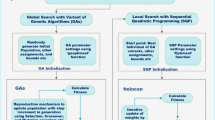Abstract
A new method to reduce the numerical dispersion of the three-dimensional Alternating Direction Implicit Finite-Difference Time-Domain (3-D ADI-FDTD) method is proposed. Firstly, the numerical formulations of the 3-D ADI-FDTD method are modified with the artificial anisotropy, and the new numerical dispersion relation is derived. Secondly, the relative permittivity tensor of the artificial anisotropy can be obtained by the Adaptive Genetic Algorithm (AGA). In order to demonstrate the accuracy and efficiency of this new method, a monopole antenna is simulated as an example. And the numerical results and the computational requirements of the proposed method are compared with those of the conventional ADI-FDTD method and the measured data. In addition the reduction of the numerical dispersion is investigated as the objective function of the AGA. It is found that this new method is accurate and efficient by choosing proper objective function.
Similar content being viewed by others
References
T. Namiki. A new FDTD algorithm based on alternating-direction implicit method. IEEE Trans. on Microwave Theory Tech., 47(1999)10, 2003–2007.
J. S. Juntunen, T. D. Tsiboukis. Reduction of numerical dispersion in FDTD method through artificial anisotropy. IEEE Trans. on Microwave Theory Tech., 48(2000)4, 582–588.
Liu Bo, Ren Wu, Gao Ben-qing, et al. An efficient method to reduce the numerical dispersion in ADI-FDTD algorithm. Journal of Microwaves, 19(2003)2, 19–23 (in Chinese).
刘 波, 任 武, 高 本庆, 等. 一种有效减少 ADI-FDTD 数 值色散的方法. 微波学报, 19(2003)2, 19–23.
A. P. Zhao. Improvement on the numerical dispersion of 2-D ADI-FDTD with artificial anisotropy. IEEE Microwave Wireless Compon. Lett., 14(2004)6, 292–294.
M. Srinivas, L. M. Patnaik. Adaptive probabilities of crossover and mutation in genetic algorithms. IEEE Trans. on Syst., Man, and Cybernetics, 24(1994)4, 656–667.
F. Zheng, Z. Chen. Numerical dispersion analysis of the unconditionally stable 3-D ADI-FDTD Method. IEEE Trans. on Microwave Theory Tech., 49(2001)5, 1006–1009.
R. Luebbers, L. Chen, T. Uno, et al. FDTD calculation of radiation patterns, impedance, and gain for a monopole antenna on a conducting box. IEEE Trans. on Antennas Propagat., 40(1992)12, 1577–1583.
G. Sun, C. W. Treuman. Analysis and numerical experiments on the numerical dispersion of two-dimensional ADI-FDTD. IEEE Antennas Propagat. Lett., 2(2003)2, 78–81.
Author information
Authors and Affiliations
Corresponding author
Additional information
Supported by the National Natural Science Foundation of China (No. 60271012) and Research Foundation of ZTE Corporation.
Communication author: Zhang Yan, born in 1980, male, Ph.D. candidate. School of Electronics and Information Engineering, Beijing University of Aeronautics and Astronautics, Beijing 100083, China.
About this article
Cite this article
Zhang, Y., Lü, S. & Gao, W. Genetic algorithm in reduction of numerical dispersion of 3-D ADI-FDTD method. J. of Electron.(China) 24, 380–383 (2007). https://doi.org/10.1007/s11767-005-0212-9
Received:
Revised:
Published:
Issue Date:
DOI: https://doi.org/10.1007/s11767-005-0212-9
Key words
- Finite-Difference Time-Domain (FDTD)
- Alternating-Direction Implicit (ADI)
- Numerical dispersion
- Artificial anisotropy
- Genetic Algorithm (GA)




